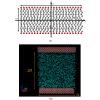当前位置:
X-MOL 学术
›
Phys. Rev. E
›
论文详情
Our official English website, www.x-mol.net, welcomes your feedback! (Note: you will need to create a separate account there.)
Decomposing thermal fluctuations with hydrodynamic modes.
Physical Review E ( IF 2.4 ) Pub Date : 2020-06-22 , DOI: 10.1103/physreve.101.063104 Xiaohui Deng 1 , Xiaoyu Wei 2 , Xiaoping Wang 2 , Ping Sheng 1
Physical Review E ( IF 2.4 ) Pub Date : 2020-06-22 , DOI: 10.1103/physreve.101.063104 Xiaohui Deng 1 , Xiaoyu Wei 2 , Xiaoping Wang 2 , Ping Sheng 1
Affiliation

|
We have obtained analytically the complete set of hydrodynamic modes (HMs) for a two-dimensional (2D) fluid confined within a channel with the Navier slip boundary condition at the hydrodynamic boundary. The HMs are orthogonal to each other and hence each represents an independent degree of freedom. We show that the HMs can be used to recursively generate a time series of random thermal fluctuations of displacement velocity, with identical statistical distributions as those obtained from MD simulations. By projecting the HMs onto molecular dynamics (MD) configurations and evaluating the resulting decay time from the autocorrelation function, we obtain from MD the eigenvalues of the HMs. Multiplying two different HMs and integrating as a function of from center of the channel towards the fluid-solid interface, the position of the hydrodynamic boundary (HDB) is unambiguously identified as the point at which the integral vanishes. Invariably the HDB is located inside the fluid domain and not on the liquid-solid interface. With the knowledge of the HDB position, the value of the slip length can be obtained directly from HM's dispersion relation. We show that in terms of the complete set of HMs, the fluctuation-dissipation theorem may be expressed in a simple expression involving the average of the inverse of the eigenvalues. Besides offering an alternative perspective on thermal fluctuations and hydrodynamic boundary, the present work opens the possibility of using modulated boundary conditions to manipulate thermal fluctuations in mesoscopic channels, which can lead to interesting statistical mechanical consequences.
中文翻译:

用流体动力学模式分解热涨落。
我们已经获得了二维(2D)流体的完整流体力学模式(HMs)集合,该流体被限制在一个通道内,并且在流体动力学边界处有Navier滑动边界条件。HM彼此正交,因此每个HM代表独立的自由度。我们表明,HMs可用于递归生成位移速度随机热波动的时间序列,其统计分布与从MD模拟获得的统计分布相同。通过将HMs投影到分子动力学(MD)构型上并通过自相关函数评估所得的衰减时间,我们从MD中获得HMs的特征值。乘以两个不同的HM并根据从通道中心到流固界面,流体动力学边界(HDB)的位置被明确标识为积分消失的点。HDB始终位于流体域内部,而不位于液固界面上。有了HDB位置的知识,就可以直接从HM的色散关系中获得滑移长度的值。我们表明,根据完整的HM集,波动耗散定理可以用一个简单的表达式表示,该表达式涉及特征值的倒数的平均值。除了提供有关热涨落和流体动力边界的替代观点之外,本研究还为使用调制边界条件来操纵介观通道中的热涨落开辟了可能性,
更新日期:2020-06-22
中文翻译:

用流体动力学模式分解热涨落。
我们已经获得了二维(2D)流体的完整流体力学模式(HMs)集合,该流体被限制在一个通道内,并且在流体动力学边界处有Navier滑动边界条件。HM彼此正交,因此每个HM代表独立的自由度。我们表明,HMs可用于递归生成位移速度随机热波动的时间序列,其统计分布与从MD模拟获得的统计分布相同。通过将HMs投影到分子动力学(MD)构型上并通过自相关函数评估所得的衰减时间,我们从MD中获得HMs的特征值。乘以两个不同的HM并根据从通道中心到流固界面,流体动力学边界(HDB)的位置被明确标识为积分消失的点。HDB始终位于流体域内部,而不位于液固界面上。有了HDB位置的知识,就可以直接从HM的色散关系中获得滑移长度的值。我们表明,根据完整的HM集,波动耗散定理可以用一个简单的表达式表示,该表达式涉及特征值的倒数的平均值。除了提供有关热涨落和流体动力边界的替代观点之外,本研究还为使用调制边界条件来操纵介观通道中的热涨落开辟了可能性,



























 京公网安备 11010802027423号
京公网安备 11010802027423号